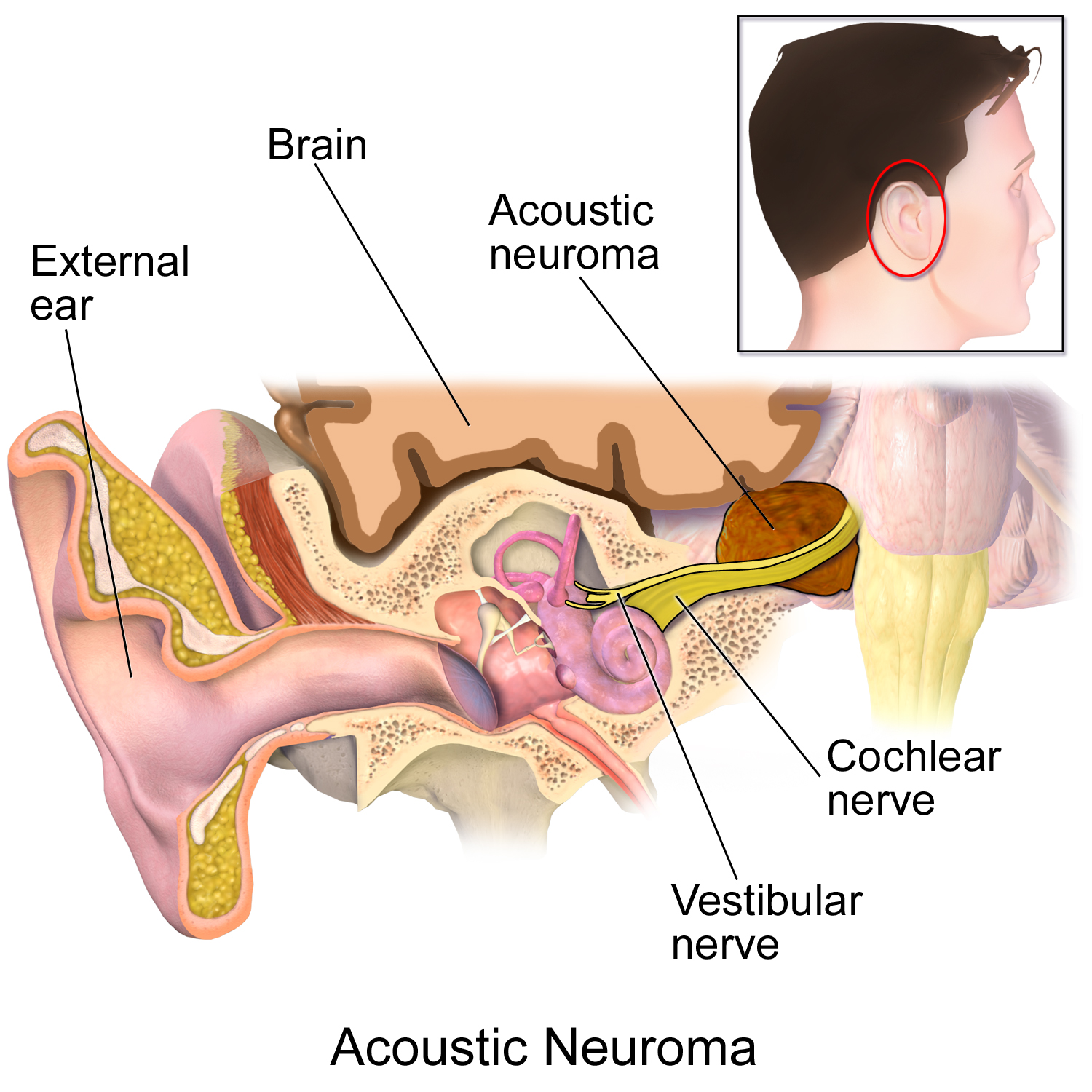This excerpt is from ANAC’s 40th Anniversary Celebration, held virtually in October 2023. It features a presentation by Michelle Gillespie, National Operations Director.
What is an Acoustic Neuroma?
An acoustic neuroma (AN), also called a vestibular schwannoma (VS), is a rare, benign (non-cancerous) brain tumour. It grows slowly on the hearing and balance nerve (the eighth cranial nerve), which connects the inner ear to the brain.
Although not cancer, the tumour can cause serious problems as it grows. It may press on nearby nerves—affecting hearing, balance, and sometimes the face—or even push on the brain if left untreated.

Blausen.com staff (2014). "Medical gallery of Blausen Medical 2014". WikiJournal of Medicine 1 (2). DOI:10.15347/wjm/2014.010. ISSN 2002-4436., CC BY 3.0 <https://creativecommons.org/licenses/by/3.0>, via Wikimedia Commons
Learn the Signs of Acoustic Neuroma
Acoustic neuromas often develop slowly, and early symptoms can be subtle. The most common signs include:
- Hearing loss on one side – often gradual and sometimes only noticeable in certain situations
- A feeling of “fullness” in the ear – a sense of pressure or blockage
- Ringing or other noises in the ear (tinnitus) – persistent or intermittent sounds such as buzzing, hissing, or whistling
- Balance problems – unsteadiness, dizziness, or vertigo
Other symptoms that may occur include:
- Facial numbness, twitching, weakness, or loss of muscle movement
- Swallowing difficulties
- Changes in taste
- Altered tear production
- Vision changes, including double vision or reduced visual acuity
- Headaches or other pain
- Fatigue or feelings of tiredness
- Brain fog or cognitive changes
Track and Report Your Symptoms
Keeping a detailed record of your symptoms is crucial for early detection and effective management. Consider tracking:
- Onset and duration of symptoms
- Severity (mild, moderate, severe)
- Frequency and triggers
- Changes over time
Why it matters:
- Helps your healthcare provider identify patterns that may indicate the presence of a tumour
- For those already diagnosed, tracking symptoms can also help monitor tumor growth or changes over time
- Supports timely referrals for hearing tests or imaging
- Ensures that subtle or intermittent symptoms are not overlooked
- Provides a clear record if you need to see multiple specialists
A symptom diary, smartphone app, or calendar notes can all be effective ways to track changes. Bring this record to appointments—it can make a significant difference in care decisions. For those already diagnosed, tracking symptoms can also help monitor tumour growth or changes over time.
Diagnosis
When symptoms suggest an acoustic neuroma, the diagnostic process often begins with a hearing test, which can detect asymmetry or hearing loss. However, some people are diagnosed based on balance problems, dizziness, or facial numbness, even if hearing changes are subtle.
If abnormalities are detected, your doctor may recommend further imaging, including:
-
Computerized Tomography (CT) scan – provides detailed images of bone structures and can help rule out other causes
-
Magnetic Resonance Imaging (MRI) scan – an MRI with contrast is the gold standard for diagnosing acoustic neuromas, giving clear images of the tumor and its relationship to surrounding structures
Additional tests may be used depending on your symptoms:
-
Vestibular (balance) testing – evaluates how well your balance system is working
- Eye exam – can detect papilledema (swelling of the optic nerve), which may occur if a tumor is affecting intracranial pressure
Early tracking and reporting of symptoms—including hearing changes, balance issues, or facial sensations—can help your healthcare provider detect the tumor sooner, which may broaden treatment options and improve outcomes.
Understanding Your Treatment Options
Treatment for acoustic neuroma is personalized, depending on tumour size, location, growth, overall health, and patient preferences. Making an informed decision often involves consulting a multi-disciplinary care team.
Multi-Disciplinary Care
Your care team may include:
- Skull-Base Neurosurgeon
- ENT – Head and Neck Surgeon
- Radiation Oncologist
- Audiologist / Vestibular Specialist
- Neurologist / Neuropsychologist
- Radiologist
Key Points:
- Consulting multiple specialists ensures a full understanding of risks, benefits, and outcomes.
- Second opinions are encouraged if time allows.
- Shared decision-making ensures treatment aligns with both medical needs and personal priorities.
Treatment Approaches
1. Watch & Wait (Observation)
- Regular MRI scans and hearing/balance tests.
- Immediate intervention is reserved for tumor growth or worsening symptoms.
2. Surgery
- Typically performed by a skull-base neurosurgeon, often with an ENT surgeon.
- Goal: Remove the tumor while preserving facial nerve function and hearing.
3. Radiation Therapy
- Targeted, non-invasive radiation performed under the supervision of a radiation oncologist
- Goal: Stop tumour growth
Pre-Treatment Baseline Testing
- Baseline testing helps track hearing, balance, nerve, and cognitive function
- Consult your care team about which assessments are recommended for you
Key Takeaway:
This page provides an overview. Members have access to expanded resources with detailed guidance on specialists, testing, and recovery.
Living with an Acoustic Neuroma
Treatment and recovery look different for each person. Some people experience lasting changes such as hearing loss, balance issues, or facial weakness. Others adjust with time, support, and rehabilitation.
You are not alone. Support is available through healthcare teams, family and friends, and patient organizations like the Acoustic Neuroma Association of Canada (ANAC).
ANAC is here to help. We connect you with trusted information, peer support, and resources to guide you through diagnosis, treatment, and life after an acoustic neuroma.


